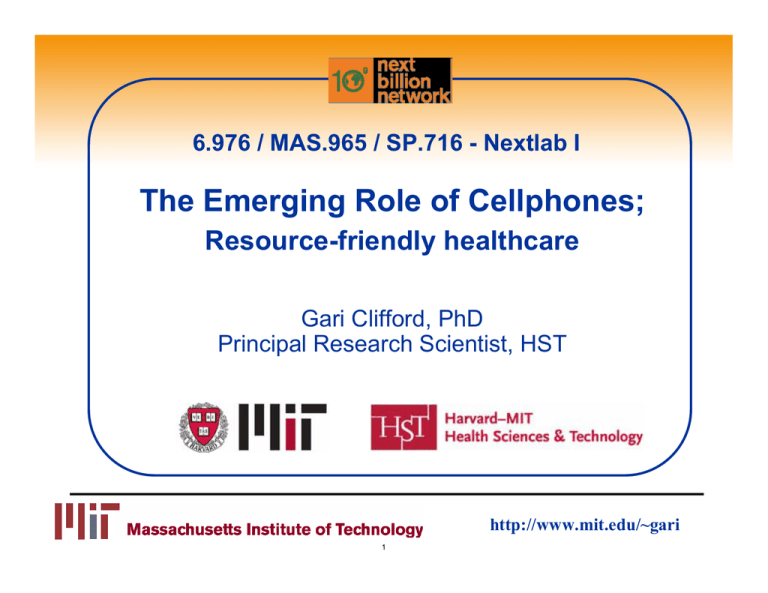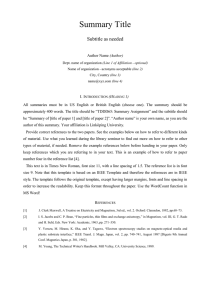The Emerging Role of Cellphones; Resource-friendly healthcare Gari Clifford, PhD
advertisement

6.976 / MAS.965 / SP.716 - Nextlab I The Emerging Role of Cellphones; Resource-friendly healthcare Gari Clifford, PhD Principal Research Scientist, HST http://www.mit.edu/~gari 1 Existing Technology & Infrastructure • Old legacy hardware & instruments • Generally paper notes, static information • Poor communication channels • Poor drug storage and supply • Poor waste disposal • Poor transport • Intermittent electricity • Information shortage • Skills shortages 2 Images © Gari Clifford, Creative Commons License - http://creativecommons.org/licenses/by-nc-nd/3.0/us/ What is changing? • Over 80% of humans live within range of a cellphone tower • Over 2 billion cellphone subscriptions worldwide • Cellphone usage increasing up to 30% annually* • Cost per flop dropping analogous to Moore’s law • Integrated peripherals increasing every year (Camera, Video, Accelerometer, GPS, larger screens) • Battery storage technology improving every year • Cost per kilobyte dropping every year • Cost of hardware dropping every year * (India, 2007) Map removed due to copyright restrictions. Tigo’s GSM coverage in Guatemala. http://www.tigo.com.gt/seccion/mapa-de-cobertura-gsm-y-35g 3 Why particularly cellphones? • Don’t think of it as a phone – it’s a mobile hand-held computer with integrated communication and sensors. • What’s unique about this hardware for medical care? – Multi-functional and self-contained: but parts are no use for other devices; user will not strip it for battery or other uses. – Easy to charge even when no grid electricity available (can even use windup generators), – Easy to hide, disguise and keep safe (in pocket), – Interchangeable & standardized, – Easy to replace – plenty of supply, – No proprietary cabling to replace (wireless communication) – Significant computational power in one device! – A.I.? – Humans want (need) to communicate – they will ensure that the device is always working and are highly motivated to have it repaired quickly if it is their primary method of communication! 4 An example: Cervical cancer screening Issues: • Skills to read images of cancer are limited (e.g. menopause is difficult to differentiate from cancer) • 2nd opinion requires a multi-step process to send image & receive feedback Image removed due to copyright restrictions. Three stages in development of cervical cancer, from http://www.preventcervicalcancer.ie/what_causes_it.asp. • Patient may have left clinic (and never return) by time diagnosis arrives • Images can be out of focus over/under-exposed or contain lighting artifacts 5 Peri-urban and rural health care • ~5 minutes per patient! • Rapid & accurate evaluation and information retrieval needed 6 Images © Rachel Hall Clifford, Creative Commons License - http://creativecommons.org/licenses/by-nc-nd/3.0/us/ What can cellphones do to help? • Replace existing cameras for taking and storing images • Provide instant transmission of images for remote diagnosis • Archive data for follow-up and quality audits • Provide training for automated classifiers: – Artificial Intelligence (AI) can be thought of as the mimicry of complex human task, such as medical diagnosis, by a computer. – AI can be achieved through computer algorithms that have been trained on data labeled by humans – AI algorithms that have been trained on data labeled by human experts can often be taught to classify similar data as well as the human experts themselves (in less time, and more consistently) [Balas 2001, Phinjaroenphan et al 2004, Tulpule et al 2005, Zimmerman et al 2006, Luck et al 2006, Gordon et al 2007] 7 Usage Scenario • Standard Smartphone with built-in 5MP+ camera and flash. • Transmit data to remote website/database • Multiple experts label images (and parts of images) • Consensus of experts decides on real classification • SMS diagnosis and treatment back to doctor • Patient treated immediately – not lost! 8 Future directions: Decision support • After data is labeled, software is trained and downloaded to phone • On-board software will: – present image to on-board classification software – upload image to remote server with meta-data – provide feedback to user • Feedback from user to improve data set after expert consultation • Automated back-up of data, classification accuracy assessment and treatment efficacy tracking • Users can be encouraged to improve data collection at the source; if the algorithm isn’t sure, or thinks the image is out of focus or at strange angle, it can ask user to take another picture 9 Modality of use • AI can provide instant classification in most cases • In dubious cases, images can be retaken with software guiding user; in this way, user is trained to take better photos. • If still unclear, image is referred to multiple experts. • Expert classifications are folded back into training set and phone software is updated automatically. • Database can cross-validate in background and detect if changes are occurring in population – Is the disease manifesting in a previously unknown manner? Software can adapt to changes in population over time. • Software can show user where it suspects the cancerous region may be and provide an explanation of why it is cancerous (“large dark mass”) or not (“patient is post-menopausal”) 10 Conclusions • Potential of mobile computing is enormous • Can provide expert diagnosis in an instant • Will provide a large database of cases to continue improvements of diagnosis, and of allow doctors to track patient’s recovery over time • Low cost and easily maintained technology. • Very few points of failure (no cables, local hard disks or electricity supply problems) • System can train local talent and improve local expertise • Secure Integrated Electronic Medical Record will allow users to keep control of their medical data without worrying about it being lost when they transfer between clinics, see new doctors, or go on holiday. • Software-intensive, extensible, resource-light solution! 11 Summary – why can this work where before it was difficult? 1. Driven from within - cellphones are not being imposed on developing countries - they are self-identified wants/needs. 2. Users are incentivized to maintain them (electricity and functionality) as they are their primary communication facilitator after the voice. 3. Ubiquitous - it's easy to get a replacement part/phone. 4. Easy to carry & conceal and harder to steal than usual 5. No peripherals or cables required so there are few points of failure 6. Backing-up is automatic, it doesn't require the user to remember or bother. 7. The platform is intelligent - it can be programmed in a similar manner to a computer and can assist in diagnosis and training. It can teach AND learn. 8. Flexible - can provide a general platform for data gathering and diagnosis/treatment 9. Extensible to other fields (e.g. tracking agricultural crop growth/diseases) 12 Reading List • Robert A. Malkin, Design of Health Care Technologies for the Developing World, Annu. Rev. Biomed. Eng. 2007. 9:567–87 (Required). • Robert A Malkin TOPICAL REVIEW; Technologies for clinically relevant physiological measurements in developing countries. 2007 Physiol. Meas. 28 R57-R63 doi:10.1088/0967-3334/28/8/R01. • Fraser HSF, Jazayeri D, Nevil P, Karacaoglu Y, Farmer PE, Lyon E, Smith-Fawzi MK, Leandre F, Choi S, Mukherjee JS. An information system and medical record to support HIV treatment in rural Haiti. British Medical Journal, 2004; 329;1142-1146. • Szot A, Jacobson F, Munn S, Jazayeri D, Nardell E, Harrison D, Drosten R, Ohno-Machado L, Smeaton LM, Fraser HSF. Diagnostic Accuracy of Chest X-rays Acquired Using a Digital Camera for Low-Cost Teleradiology. Int. J. Med. Inform., 2004; 73(1): 65-73. • Joaquin A Blaya , Sonya S Shin , Martin JA Yagui , Gloria Yale , Carmen Z Suarez , Luis L Asencios , J Peter Cegielski and Hamish SF Fraser. A web-based laboratory information system to improve quality of care of tuberculosis patients in Peru: functional requirements, implementation and usage statistics. BMC Medical Informatics and Decision Making 2007, 7:33doi:10.1186/1472-6947-7-33. http://www.biomedcentral.com/1472-6947/7/33 • Gari D Clifford, Joaquin A Blaya, Rachel Hall-Clifford, Hamish SF Fraser Medical information systems: A foundation for healthcare technologies in developing countries. BioMedical Engineering OnLine 2008, 7:18 (11 June 2008) . 13 References • Gordon, S.; Greenspan, H., "SEGMENTATION OF NON-CONVEX REGIONS WITHIN UTERINE CERVIX IMAGES," Biomedical Imaging: From Nano to Macro, 2007. ISBI 2007. 4th IEEE International Symposium on , vol., no., pp.312-315, 12-15 April 2007 • Trujillo, E.V.; Sandison, D.; Ramanujam, N.; Follen-Mitchell, M.; Cantor, S.; Richards-Kortum, R., "Development of a cost-effective optical system for detection of cervical pre-cancer," Engineering in Medicine and Biology Society, 1996. Bridging Disciplines for Biomedicine. Proceedings of the 18th Annual International Conference of the IEEE , vol.1, no., pp.191-193 vol.1, 31 Oct-3 Nov 1996 • Zimmerman, G.; Gordon, S.; Greenspan, H., "Automatic landmark detection in uterine cervix images for indexing in a content-retrieval system," Biomedical Imaging: Nano to Macro, 2006. 3rd IEEE International Symposium on , vol., no., pp. 1348-1351, 6-9 April 2006 • Tulpule, B.; Shuyu Yang; Srinivasan, Y.; Mitra, S.; Nutter, B., "Segmentation and Classification of Cervix Lesions by Pattern and Texture Analysis," Fuzzy Systems, 2005. FUZZ '05. The 14th IEEE International Conference on , vol., no., pp.173-176, 25-25 May 2005 • Luck, B.L.; Carlson, K.D.; Bovik, A.C.; Richards-Kortum, R.R., "An Image Model and Segmentation Algorithm for Reflectance Confocal Images of In Vivo Cervical Tissue," Image Processing, IEEE Transactions on , vol.14, no.9, pp. 1265-1276, Sept. 2005 • Phinjaroenphan, P.; Bevinakoppa, S., "Automated prognostic tool for cervical cancer patient database," Intelligent Sensing and Information Processing, 2004. Proceedings of International Conference on , vol., no., pp. 63-66, 2004 • Montesinos, L.; Puentes, J.; Madrid, A.; Parra, A.; Solaiman, B.; Roux, C., "Integrated telediagnostic and epidemiological system to reduce cervical cancer incidence in Mexico," Engineering in Medicine and Biology Society, 2003. Proceedings of the 25th Annual International Conference of the IEEE , vol.2, no., pp. 1244-1247 Vol.2, 17-21 Sept. 2003 • Drezek, R.; Follen, M.; Richards-Kortum, R., "Optical imaging for the detection of cervical cancers in vivo," Biomedical Imaging, 2002. Proceedings. 2002 IEEE International Symposium on , vol., no., pp. 816-819, 2002 • Balas, C., "A novel optical imaging method for the early detection, quantitative grading, and mapping of cancerous and precancerous lesions of cervix," Biomedical Engineering, IEEE Transactions on , vol.48, no.1, pp.96-104, Jan 2001 • Schilling T, Miroslaw L, Glab G, Smerka M, Towards rapid cervical cancer diagnosis: automated detection and classification of pathologic cells in phasecontrast images. International Journal of Gynecological Cancer, Volume 17, Number 1, January/February 2007 , pp. 118-126(9) • Acosta-Mesa, H.G.; Zitova, B.; Rios-Figueroa, H.V.; Cruz-Ramirez, Nicandro.; Marin-Hernandez, A.; Hernandez-Jimenez, R.; Cocotle-Ronzon, B.E.; Hernandez-Galicia, E., "Cervical cancer detection using colposcopic images: a temporal approach," Computer Science, 2005. ENC 2005. Sixth Mexican International Conference on , vol., no., pp. 158-164, 26-30 Sept. 2005 • Palcic B, MacAulay C, Shlien S, Treurniet W, Tezcan H, Anderson G., Comparison of three different methods for automated classification of cervical cells. Anal Cell Pathol. 1992 Nov;4(6):429-41. 14 MIT OpenCourseWare http://ocw.mit.edu MAS.965/ 6.976 / EC.S06 NextLab I: Designing Mobile Technologies for the Next Billion Users Fall 2008 For information about citing these materials or our Terms of Use, visit: http://ocw.mit.edu/terms.




